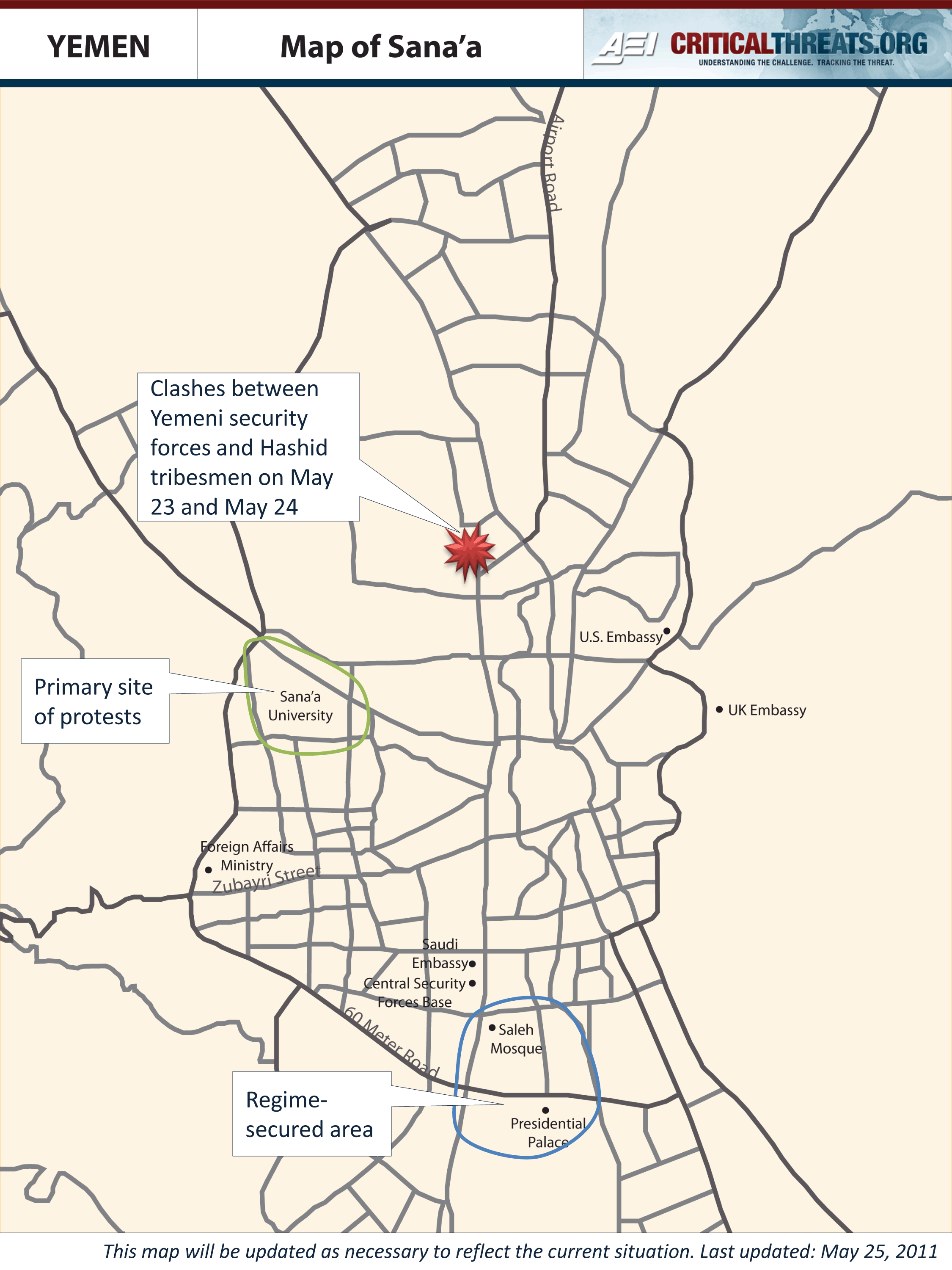The clashes in Sana’a continued into a third day, pushing the country toward the brink of a broader armed conflict. Tribal blockades and government checkpoints have been set up in central Sana’a as the two sides establish military positions. Tribesmen now control at least two government ministries – the Ministry of Trade and Tourism and the Interior Ministry – and state-run buildings such the state news agency, SABA, and the state airline headquarters, Yemenia. There are reports that tribesman have also seized the Education and Local Administration headquarters. Civilians fled the surrounding neighborhoods.
Yemeni President Ali Abdullah Saleh said, “What happened was a provocative act to drag us into civil war, but it is limited to the Ahmar sons. They bear responsibility for shedding the blood of innocent civilians.” Saleh, who refused to sign a transition deal on May 22, said, “I am ready to sign within a national dialogue and a clear mechanism. If the mechanism is sound, we will sign the transition of power deal and we will give up power.”
President Barack Obama said in a meeting with British Prime Minister David Cameron, “We are proud of the leadership of the [Gulf Cooperation Council] in seeking an orderly and peaceful resolution to the crisis and we call on President Saleh to move immediately on his commitment to transfer power.”
On May 22, President Saleh refused to sign the transition agreement in the absence of Yemeni opposition leaders, warning that the leaders were dragging the country into a civil war. The opposition leaders who had signed the deal on May 21 refused to enter the presidential palace while Saleh was still in power, making such a face-to-face mutual signature impossible. Earlier, an armed mob, with ties to the government, massed outside the UAE Embassy to stop the U.S., UK and EU ambassadors, GCC head Abdul Latif al Zayani, and other Gulf ambassadors from going to the presidential palace for Saleh to sign the agreement. Yemeni military helicopters evacuated the foreign dignitaries to the presidential palace after nightfall. The GCC has now withdrawn its Yemen initiative.
Clashes between Hashid tribesmen and Yemeni security forces broke out in north Sana’a in al Hasaba neighborhood on May 23. It is not clear who instigated them. The fighting occurred near defected Hashid tribal leader Sheikh Sadiq al Ahmar’s compound and killed at least six people. Hashidis seized Yemen’s Interior Ministry and as a position from which to attack nearby troops loyal to Saleh sheltering in the nearby state news agency building. Loyalist troops fired mortar shells at Sadiq’s house while a mediation committee was meeting there on May 24. The attack reportedly killed two tribal leaders. The fighting has killed seventeen tribesmen, fourteen soldiers, and ten civilians overall. Defected General Ali Mohsen al Ahmar’s troops were also involved in the fighting near the general’s headquarters, but with no reported casualties.
The unrest in Yemen has challenged an already fragile state. Mass demonstrations are occurring daily in Yemen’s major cities and these have been met with an increasing use of force. The opposition, united in its demand for the president’s resignation, has not been able to force Saleh out of power over the past few months, which decreases the likelihood of a relatively peaceful transition.
If you would like to receive these updates by email, please sign up here.

